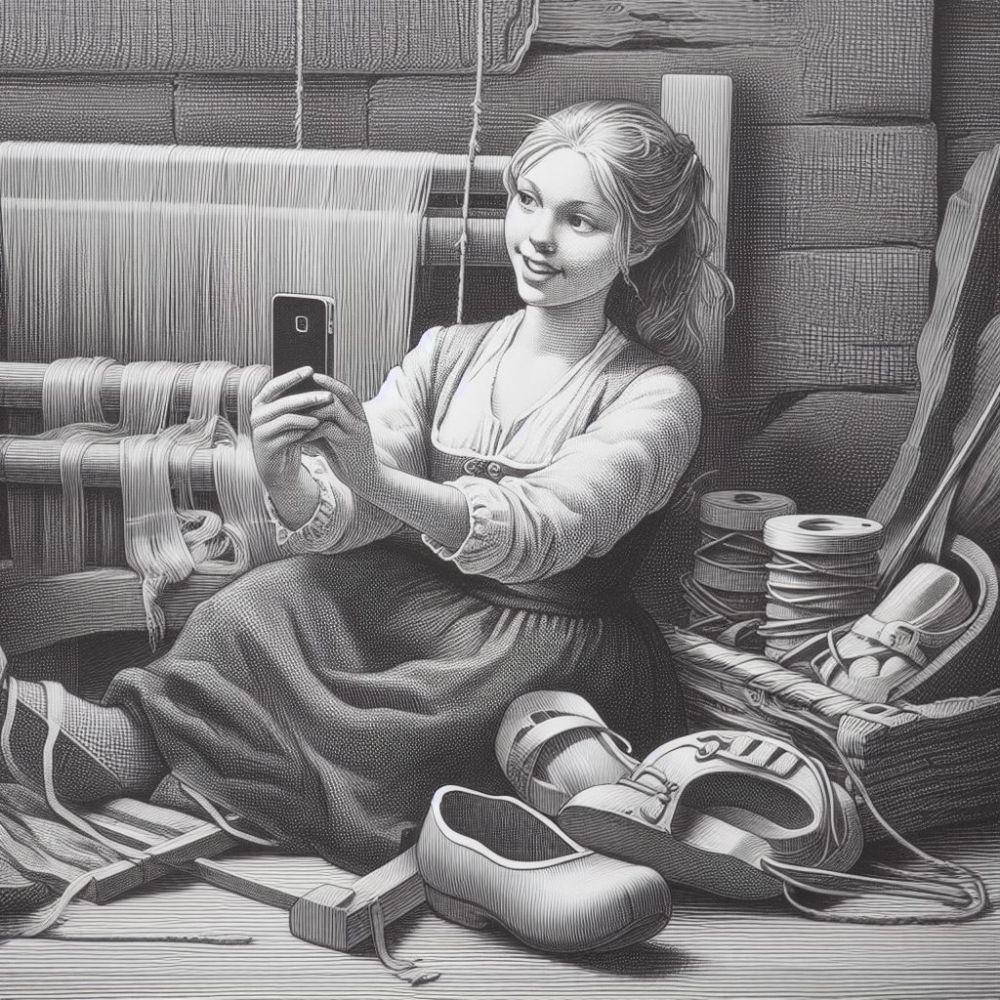Jacquard loom: Difference between revisions
Amwelladmin (talk | contribs) No edit summary |
Amwelladmin (talk | contribs) No edit summary |
||
| (One intermediate revision by the same user not shown) | |||
| Line 16: | Line 16: | ||
===Sabotage!=== | ===Sabotage!=== | ||
The Jacquard loom | The Jacquard loom put many textile workers out of a job. It is said — implausibly, it seems — that these weavers who, with the fashion at the time, wore wooden French [[clogs]] called “''sabots''”, not best pleased with being pitched into [[redundancy]] — threw their clogs into the delicate machinery, wreaking havoc. This practice became so popular they gave it a name: “sabotage”. | ||
Friendly buzz-killers have since written to advise that the word did not reach the common idiom until the start of the 20th century, so clog-throwing weavers “is not supported by the etymology”. Rather, sabotage was originally a kind of [[work-to-rule]]: to work so slowly and clumsily as to resemble a peasant, peasants being in the habit of wearing wooden clogs — hence sabotage which, we suppose, means “cloggishness”. | |||
In the mean time the poor, truculent, bare-footed hand-weavers has no time to throw their clogs in the loom or enjoy their new-found “leisure”, much less to pen think-pieces about [[technological unemployment]] or [[universal basic income]], for they were urgently needed to programme, maintain and enhance these fancy new automatic looms. They re-specialised. Now their skill was ''programming the Jacquard loom'' and ''designing faster, fancier, more flexible Jacquard looms''.<ref>Now, no doubt, some of them couldn’t figure out how to switch it on, failed to become programmers, and had a lousy time. This happens.</ref> | |||
===The new 2020 model Jacquard=== | ===The new 2020 model Jacquard=== | ||
Latest revision as of 15:19, 8 November 2023
|
JC pontificates about technology
An occasional series.
|
The Jacquard loom was a power loom that simplified the process of manufacturing textiles with such complex patterns as brocade, damask and matelassé with the use of punched cards. It was invented by Joseph Marie Jacquard in 1804, and technology guru James Burke — a super cool seventies guy and former of great impressions on the young JC — hailed it as an early example of a computer in his magnificent, formative-impression inducing TV series, Connections.
Now, in 1805, was there a thought leader on hand to declare, “Right. That’s it. Human usefulness as we know it is over. We are all going to become machines”?
Not as far as we know. There probably was, but his hot take was buried in the irresistible torrent of progress and no record remains of him or his sagacity.
In the meantime, what happened to intricately-woven fabric, now it could be quickly produced with minimal labour? Did this mean rentier capitalists, finally freed of the burden of wasteful servants, could reap colossal margins while their monstrous machines pumped out acres and acres of expensive fabric for an insatiable market of wealthy, but now underemployed, former hand-weavers?
Well, it didn’t, did it, readers? Woven fabric plummeted in price. Of course it did. Because anyone could produce it now. All you needed was a Jacquard loom. And all of a sudden every bugger was buying Jacquard looms.
Did it permanently put a sector of society out of work? It did not do that either. To be sure; there was far less call for hand-weaving, but artisan hand-weavers figured it out.
Who could have predicted that?[1] Loom owners no longer needed hand-weavers.
Sabotage!
The Jacquard loom put many textile workers out of a job. It is said — implausibly, it seems — that these weavers who, with the fashion at the time, wore wooden French clogs called “sabots”, not best pleased with being pitched into redundancy — threw their clogs into the delicate machinery, wreaking havoc. This practice became so popular they gave it a name: “sabotage”.
Friendly buzz-killers have since written to advise that the word did not reach the common idiom until the start of the 20th century, so clog-throwing weavers “is not supported by the etymology”. Rather, sabotage was originally a kind of work-to-rule: to work so slowly and clumsily as to resemble a peasant, peasants being in the habit of wearing wooden clogs — hence sabotage which, we suppose, means “cloggishness”.
In the mean time the poor, truculent, bare-footed hand-weavers has no time to throw their clogs in the loom or enjoy their new-found “leisure”, much less to pen think-pieces about technological unemployment or universal basic income, for they were urgently needed to programme, maintain and enhance these fancy new automatic looms. They re-specialised. Now their skill was programming the Jacquard loom and designing faster, fancier, more flexible Jacquard looms.[2]
The new 2020 model Jacquard
What, 200 odd years later, do you think you are currently staring at? A faster, fancier, more flexible Jacquard loom.
